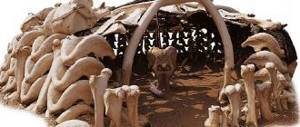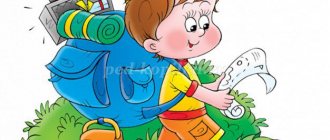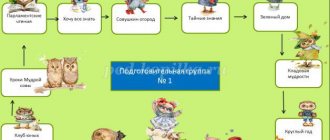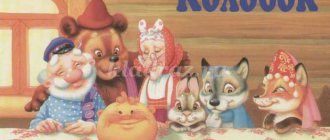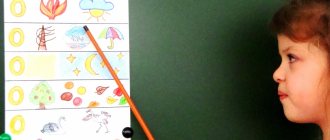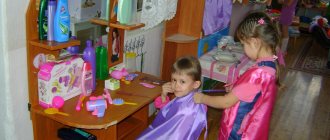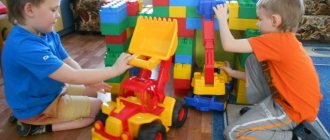Using the technology “Journey along the River of Time” in working with preschoolers
Natalia Bobykina
Using the technology “Journey along the River of Time” in working with preschoolers
Currently, teaching staff of preschool educational institutions are intensively introducing innovative technologies into their work . Therefore, the main task of preschool is to choose methods and forms of organizing work with children , innovative pedagogical technologies that optimally correspond to the goal of personal development. Modern pedagogical technologies in preschool education are aimed at implementing state standards for preschool education .
In the process of active cognitive activity, the child expands his ideas about the world and masters temporary relationships . Learning the values of material culture within a certain time frame , the child learns to correlate the memory of the past and his own individual memory, acquires knowledge of who a person is and what his purpose is on Earth, what the world is like as a set of connections, entities, things.
In my work I actively use the technology “ Journey along “ River of Time ”
, which is aimed at streamlining
temporal relations (ideas about historical time - from the past to the present using examples of material civilization, as well as the child’s own life line, the history of his family).
This technology was first proposed by N. A. Korotkova, as one of the forms of cognitive and research activity of children of senior preschool age . Journey along " river of time "
It does not aim to provide children with detailed historical information.
The main thing is to create in the child’s imagination holistic images of human history through “marks”
- symbols of material civilization.
The starting point of the study can be both real events and simulated ones.
Based on the event, the teacher poses a research question. Each question forces children to compare, establish possible connections and relationships between events. The teacher discusses the ideas and assumptions expressed with the children. The discussion takes place in a round table
around key subject material.
At this stage, the teacher widely uses real subject and illustrative material. There should be several real objects so that each child can test the capabilities of the material being studied. The illustrative material proposed for the study consists of cards of various sizes, from fairly large to small, which are examined by all participants, passing from hand to hand. Only with such work with illustrative material is it possible to have an active discussion and find connections and dependencies.
Next stage: fixing “marks”
on the “river
of time ” .
Children can act both individually and in subgroups, depending on the context and the material offered. Subgroups of children can disperse and then unite again at a round table
to assemble panels, final discussion, and compare research results.
Panel "river of time "
it should be
“open”
for addition - in the free independent activity of children, to activate them. At the same time, it should be mobile: at the next lesson you should be able to remove it from the wall and
use it for further “research”
.
Map-panel ( “river of time ”
- this is a long paper sheet measuring 50*160 cm or 60*180 cm) symbolizes the linear movement of historical
time : from past to present. “stops”
are planned along it , with loose names that are intuitive for children, for example,
“antiquity”
-
“old times”
-
“our
time ” .
The teacher sticks small illustrations on the panel in advance - “marks”
of each stop in
time .
is especially relevant in older preschool age , when children already have a certain amount of knowledge. When working with preschoolers, I set the following tasks:
1. To form in children a cognitive interest in the world around them.
2. Develop the ability to find ways to solve problems, the ability to analyze the situation.
3. Develop communication skills in preschoolers : the ability to listen to each other, work in groups , defend their point of view.
Together with participants in educational relations (children and parents)
The implementation of
“
traveling along the river of time ” technology began with the theme
“Miracles on wheels - from carts to
modern cars ” which, of course, found a great response among the boys.
The main task was to reveal to preschoolers the amazing , diverse man-made world of man, to arouse admiration for working people. Show how people changed transport, making it more convenient and safe.
the “river of time ” aroused great interest
on the topic
“My Hometown”
as part of the implementation of a project on civic and patriotic education, which made it possible to introduce children to their small Motherland - their hometown, with its history, sights, traditions, and with the people who live in it.
When studying the history of the city by children with the help of a teacher and parents, information about the history of the city of Pervouralsk was collected, photographs of the old and modern city , and a photo exhibition was organized. Adults helped the child in selecting material ( using home and city libraries, bookstores, searching for sources of additional information, Internet resources on the topic of the project).
Experience shows that the technology “ travel along the river of time ”
gives positive results in the cognitive development of children, and a figurative idea of
time “River of
Time ” panel guide contributes to the development of research activities
of preschoolers .
Literature.
1. Dybina O. V. “Introducing preschoolers to the objective world ”
: tutorial. – Pedagogical Society of Russia. – Moscow, 2007.
2. Korotkova N. A. “Educational process in groups of children of senior preschool age .” – M.: Linka-Press, 2007
3. “ Modern pedagogical technologies for the education of preschool children ”: methodological manual / author. -composition O. V. Tolstikova, O. V. Savelyeva, T. V. Ivanova (etc.)
–Ekaterinburg: State Autonomous Educational Institution of Further Professional Education SO
“IRO”
, 2014
“River of Time” technology: possibilities for implementation in preschool education
“River of Time” technology: possibilities for implementation in preschool education
Chudova Yulia
student 31DO group,
specialty 44.02.01
Preschool education
The general provisions of the Federal State Educational Standard for preschool education, which is a set of mandatory requirements for preschool education, set out its basic principles, which include the formation of the child’s cognitive interests and cognitive actions in various types of activities.
Currently, preschool educational organizations are intensively introducing innovative technologies into their work. Therefore, the main task of preschool teachers is to choose methods and forms of organizing work with children, innovative technologies that optimally correspond to the goal of personal development. Modern pedagogical technologies in preschool education are aimed at implementing state standards for preschool education. A fundamentally important aspect in pedagogical technology is the child’s position in the educational process, the attitude of adults towards the child. When communicating with children, an adult adheres to the position: “Not next to him, not above him, but together!” Its goal is to promote the development of the child as an individual.
According to the content of the Federal State Educational Standard for preschool education, modern education sets teachers the task of improving traditional and finding new technological approaches to organizing the educational process. Accordingly, the problem
, which consists in searching for methods to promote the formation of interest in preschool children in the “River of Time” technology.
The author of the technology “Journey along the “River of Time” is Nadezhda Aleksandrovna Korotkova. This technology can be used in the cognitive and research activities of children of senior preschool age. Nadezhda Aleksandrovna suggests using a didactic manual - the “River of Time” panel. The term “river of time” was not invented by N.A. Korotkova, she borrowed it from the English writer Donald Bisset, who invented it for the fairy tale “The Journey of Uncle Tick-Tock.”
The technology of “traveling along the “river of time” is aimed at mastering temporal relations (ideas about historical time - from the past to the present); develops a holistic perception of the world, logical thinking, establishes cause-and-effect relationships, the sequence of development of the world in each direction.
Traveling “along the river of time” is one of the most interesting and accessible forms of play to present children with a holistic picture of the world. It is this that allows children to get an idea of historical time; consciously find connections, relationships between phenomena of the surrounding world and fix these connections as a unique result of one’s own activities. Travel games can be used in educational activities, in children’s independent activities, as well as in educational activities during restricted periods.
The didactic manual “River of Time” is a long sheet (initially it can be wallpaper or glued sheets of whatman paper, approximately 50x160 cm or 60x18 cm in size). Along the “river of time” there are several “stops” with loose names that are intuitive for children. For example: “antiquity” - “old times” - “our time”. “Antiquity” is the era of the ancient world of primitive people; “old times” - approximately the world of the Middle Ages and a little later, “our time” - the modern world, maybe the future.
The “river of time” panel map symbolizes the linear movement of historical time: from the past to the present.
Small illustrations are pasted onto the panel in advance—“marks” for each stop in time. Such symbols—“marks”—are images of a person in an environment typical of a historical era (for example, nomads around a fire and hut, residents of a medieval fortified city, inhabitants of a modern city). Other marking symbols are also possible - maybe dwellings or something else characteristic of a certain historical era.
The stops on the “river of time” are taken over from event to event - filled with appropriate illustrative material. Where possible, the story and discussion should be supported not only by illustrations, but also by real antique things that can be examined and tried in action (for example, determine whether it was convenient to use a quill pen or a pen with an ink pen for writing). Such illustration paintings are used many times.
Stages of the technology “Journey along the River of Time”
Stage 1 – discussion of a real or fictitious event;
Stage 2 – setting up the study (find out...);
Stage 3 - analysis-comparison, active discussion of demonstration illustrative or subject material;
Stage 4 - work in subgroups: sorting and attaching small illustrations to the “river of time” panel;
Stage 5 - assembly of a general table, comparison of research results;
Stage 6 - hanging the table on the wall of the group room;
Stage 7 - children’s addition of the table in independent activities.
The peculiarity of the technology “traveling along the river of time” gives positive results in the cognitive development of children, and the figurative idea of time through the aid-panel “river of time” contributes to the development of research activities of preschoolers. A child of preschool age learns about the world around him in the process of any of his activities. “Islands” of cognitive and research activity accompany play and productive activity, intertwined with them in the form of indicative actions, testing the possibilities of any new material.
Bibliography
- Korotkova N.A. Educational process in groups of children of senior preschool age. – M.: LINKA-PRESS, 2007. – 208 p.
- Tolstikova O.V., Savelyeva O.V., Ivanova T.V., Ovchinnikova T.A., Simonova L.N., Shlykova N.S., Shelkovkina N.A. Modern pedagogical technologies for the education of preschool children: a methodological manual. – Ekaterinburg: IRO, 2013. – 199 p.
- E. A. Sypchenko “Innovative pedagogical technologies” Project method in preschool educational institutions: St. Petersburg, DETSVO-PRESS, 2012
- Yu. V. Atemaskina, L. G. Bogoslavets “Modern pedagogical technologies in preschool educational institutions”: St. Petersburg, DETSVO-PRESS, 2012.
- T. V. Khabarova “Pedagogical technologies in preschool education”: St. Petersburg, DETSVO-PRESS, 2012
